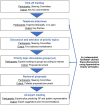Multidisciplinary approaches to identifying and managing global airways disease: Expert recommendations based on qualitative discussions
- PMID: 36895864
- PMCID: PMC9989256
- DOI: 10.3389/falgy.2023.1052386
Multidisciplinary approaches to identifying and managing global airways disease: Expert recommendations based on qualitative discussions
Abstract
Background: Chronic rhinosinusitis with nasal polyps (CRSwNP) and asthma frequently co-exist and share pathologic features. Taking a "global" treatment approach benefits diagnosis and treatment of both, but care is often siloed by specialty: joined-up clinics are uncommon. Our objectives were to explore expert opinion to give practical suggestions to identify adults needing global airways care; enhance cross-specialty working; and widen knowledge to support diagnosis and management, integrate with existing care pathways, and supplement existing guidelines.
Methods: Sixteen practicing physicians from northern Europe were invited for their national and/or international standing in treating asthma and/or chronic rhinosinusitis. Appreciative Inquiry techniques were used to guide their discussions.
Results: Key themes arising were screening and referral, collaboration on management, awareness and education, and research. Provided are screening criteria and suggestions for specialist referrals, and pointers for physicians to optimize their knowledge of global airways disease. Collaborative working is underscored, and practical suggestions are given for multidisciplinary teamworking within global airways clinics. Research gaps are identified.
Conclusion: This initiative provides practical suggestions for optimizing the care of adults with CRSwNP and asthma. Discussion of the role of allergy and drug exacerbations on these conditions, and care for patients with other global airways diseases were beyond scope; however, we expect some principles of our discussion will likely benefit patients with related conditions. The suggestions bridge asthma and CRSwNP management guidelines, envisioning interdisciplinary, global airway clinics relevant to various clinical settings. They highlight the value of joint screening for early recognition and referral of patients.
Keywords: asthma; chronic rhinosinusitis with nasal polyps (CRSwNP); global airways disease; interdisciplinary care; nasal polyps; respiratory hypersensitivity; rhinitis; sinusitis.
© 2023 Backer, Cardell, Lehtimäki, Toppila-Salmi, Bjermer, Reitsma, Hellings, Weinfeld, Aanæs, Ulrik, Braunstahl, Aarli, Danielsen, Kankaanranta, Steinsvåg and Bachert.
Conflict of interest statement
LOC has received institutional grants and/or personal fees from Orion Pharma, Sanofi, GlaxoSmithKline and ALK-Abello. LL has received honoraria for educational activities, lectures or advisory boards from ALK, AstraZeneca, Boehringer Ingelheim, Chiesi, GlaxoSmithKline, Mundipharma, Novartis, Orion, Sanofi, and Teva. ST-S has received personal fees from ALK-Abello, Mylan Laboratories, Biomedical Systems, Roche Products, Sanofi Pharma, and Novartis Investments for consultancy, and a grant from GlaxoSmithKline. LB has during the last 3 years received honoraria for educational activities, lectures, or advisory boards from ALK, AstraZeneca, Boehringer Ingelheim, Chiesi, GlaxoSmithKline, Novartis, Sanofi, and Teva. SR has received honoraria for educational activities, lectures, advisory boards, and research grants from Novartis, Sanofi, and GlaxoSmithKline. DW has received renumeration for advisory boards with Teva and AstraZeneca. KA has received honoraria for educational activities and advisory boards from Sanofi. CU has received honoraria for educational activities, lectures, and advisory boards from AstraZeneca, GlaxoSmithKline, Sanofi, Mundipharma, Teva, Boehringer Ingelheim, Novartis, Orion Pharma, Actelion, ALK-Abello, and Sandoz. BA has received honoraria for educational activities and advisory boards from GlaxoSmithKline, AstraZeneca, Novartis, Sanofi-Aventis, Boehringer Ingelheim, and Chiesi outside the submitted work. HK has received personal fees and non-financial support from AstraZeneca, personal fees from Chiesi Pharma AB, personal fees from Boehringer Ingelheim, personal fees from MSD, personal fees from Novartis, personal fees and non-financial support from Orion Pharma, personal fees from Sanofi Genzyme, and personal fees from GlaxoSmithKline, outside the submitted work. CB has received honoraria as principal investigator of the study, consultant and advisory from Sanofi and Novartis, advisory boards from GlaxoSmithKline and as principal investigator from AstraZeneca. The remaining authors declare that the research was conducted in the absence of any commercial or financial relationships that could be construed as a potential conflict of interest.
Figures


References
-
- Soriano JB, Kendrick PJ, Paulson KR, Gupta V, Abrams EM, Adedoyin RA, et al. Prevalence and attributable health burden of chronic respiratory diseases, 1990–2017: a systematic analysis for the global burden of disease study 2017. Lancet Respir Med. (2020) 8(6):585–96. 10.1016/S2213-2600(20)30105-3 - DOI - PMC - PubMed
LinkOut - more resources
Full Text Sources

